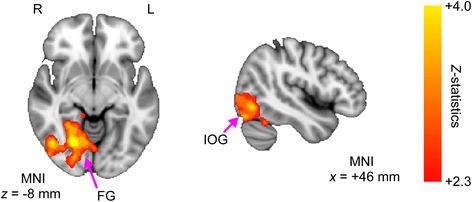Fig. 2.

Reduced fractional amplitude of low-frequency fluctuation in individuals with autism spectrum disorder (ASD) compared with normal controls (NCs). The z-map of group comparisons of the fractional amplitude of low-frequency fluctuation (fALFF) is shown (NC>ASD). Multiple comparisons were corrected based on the Gaussian random field theory (z > 2.3; cluster-level significance p < 0.05, corrected). The red-yellow color represents positive z-statistics, which indicate significant reductions in the group of individuals with ASD compared to the group of NCs. Relative to the NC group, the ASD group exhibited significant decreases in fALFF in a large cluster (4437 voxels), including the right LING, FG, IOG, and PHG. Right (R), left (L), lingual gyrus (LING), fusiform gyrus (FG), inferior occipital gyrus (IOG), and parahippocampal gyrus (PHG)
